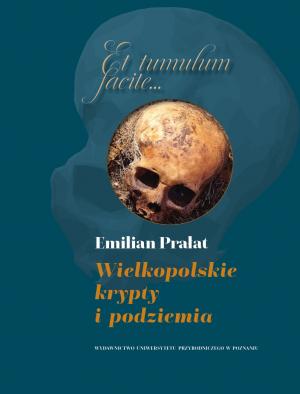(Księgarnia UPP)
Kliknięcie przycisku powoduje przeniesienie na zewnętrzną platformę udostępniania lub sprzedaży.
Sposób cytowania
Prałat, E. (2025). Et tumulum facite... Wielkopolskie krypty i podziemia. Poznań: Wydawnictwo Uniwersytetu Przyrodniczego w Poznaniu.
Książka dr. Emiliana Prałata poświęcona kryptom wielkopolskim i podziemiom to fascynująca i szczegółowa praca, która zasługuje na uwagę zarówno miłośników historii, jak i osób zainteresowanych ochroną dziedzictwa kulturowego. Autor, z niezwykłą skrupulatnością, przedstawia szereg przykładów krypt zlokalizowanych na terenie Wielkopolski, szczegółowo dokumentując ich stan, historię oraz kontekst kulturowy. Omawiana publikacja jest pierwszą z zaplanowanej serii, co pozwala przypuszczać, że kolejne tomy będą stopniowo uzupełniać indeks ważnych dla tego tematu miejsc i ostatecznie stworzą kompendium wiedzy na temat wielkopolskich nekropolii.
Jednym z najważniejszych wątków, który przewija się przez książkę, jest kwestia ochrony krypt i ich znaczenia jako elementu dziedzictwa kulturowego. Autor podkreśla, że choć wiele z tych miejsc jest obecnie w złym stanie, ich zachowanie może stanowić ważny krok w kierunku ochrony regionalnej historii oraz stworzenia potencjalnej atrakcji turystycznej dla regionu. Krypta, będąca świadectwem przeszłości, staje się tu punktem wyjścia do szerszej refleksji nad losem zabytków w Polsce oraz możliwością ich adaptacji w nowoczesnej turystyce kulturowej. Publikacja wyróżnia się również pod względem formy. Bogata bibliografia świadczy o solidnym warsztacie badawczym autora, a aneksy dostarczają dodatkowych informacji. Wszystko to sprawia, że książka nie tylko dostarcza wiedzy, ale także inspiruje do własnych poszukiwań i odkrywania historii regionu – a także może stać się przewodnikiem dla tanatoturystyki, o której wspomina we wstępie autor.
Fragment recenzji dr inż. arch. Barbary Świt-Jankowskiej
Od Recenzentki (Barbara Świt-Jankowska)
Wstęp
Et tumulum facite… Słów kilka o pochówkach
Typologia krypt i miejsc pochówków
Wielkopolskie krypty i podziemia
Białcz Stary
Bonikowo
Brodnica
Czacz
Czerwona Wieś
Głuchowo
Gryżyna
Łęki Wielkie
Rąbiń
Robaczyn
Stary Gołębin
Wyskoć
Aneks
Bibliografia
Wykazy
Indeks miejscowości
Indeks osób
Summary
Summary
Et tumulum facite… is an original publishing series devoted to the cultural and social phenomenon of crypts, undergrounds and other burial spaces, which belong to a sphere that is fundamental to civilization. This sphere does not only shape community and intergenerational tradition, but it also connects one with the sacred, constituting at the same time a special example of cultural legacy. In Polish tradition, these places are of special historical, cultural, symbolic and national importance. This volume presents 12 towns – Białcz Stary, Bonikowo, Brodnica, Czacz, Czerwona Wieś, Głuchowo, Gryżyna, Łęki Wielkie, Rąbiń, Robaczyn, Stary Gołębin, Wyskoć – with the crypts and tombs located in them. The vast majority of these burial spaces are related to noble and landed gentry families that are important for the history of Greater Poland, and, in some cases, for the history of Poland and Europe in general (Bojanowski, Chłapowski, Kęszycki, Koźmian, Mańkowski, Szołdrski, Zakrzewski, Żółtowski). None of the inventoried and examined, in this volume, places have so far been the subject of scientific reflection and conservation activities. The vast majority of them are in a condition that threatens their continued existence. This applies especially to the coffins themselves and the remains contained in them. From the anthropological and cultural point of view, crypts and undergrounds constitute, on the one hand, an important space of exclusion and marginalization, because they refer to the transience, decay, and tabooing of the presence of the absent; and, on the other hand, they constitute an element that arouses curiosity and reflects the aspiration to cross the boundaries of transience.
Each of the discussed towns received a short historical record, after which individual crypts, tombs, and necropolises were described in architectural, artistic and conservation terms, taking into account their typology. The planning documentation accompanying the inventory, combined with photographic material and descriptions of the rooms, coffins and remains, constitutes important archival material. More important figures identified in the process of conducting this research are also accompanied by biographical entries. Other integral elements of the study are copies of funeral speeches and obituaries, which draw attention to the special nature of this speech genre. At the same time, these sources complement the analytical part of the study and allow for a better contextualization of sepulchral and funeral traditions in the era at issue.
The simplest and most primitive sepulchral form, as it comes directly from an earth grave and inhumation, is a tomb in the form of an underground
chamber with a tombstone built above it. The second sepulchral form among the analyzed ones is a family necropolis, which is derived directly from the pattern of an architectural tomb with a crypt. It usually takes two forms: either a church cemetery concentrating a number of single, double or group burial chambers with tombstones, or an arrangement combining the existence of (earth) cemetery and crypt burials within the necropolis. The second variant concerns primarily the situation in which the space in the family crypt under or next to the church has been exhausted and there is a desire and need to continue the burial tradition outside the (underground) interior of the temple. The oldest, and until the 19th century the most prestigious, sepulchral form was the family crypt located under the church. In this case, there are specific variants that determine the location of the crypt(s): chancel, intersection of nave and transept, transept, main nave, space near the organ gallery or side chapel (but still within the external walls of the church and, thus, organically connected to it). This type of grave has the strongest connection with the idea that I call resurrectio per sancta sanctorum, i.e. the belief in the special soteriological power of burial in the immediate vicinity of an altar or the burial place of a saint. The form of the family crypt that evolved from the crypt beneath the church is the chapel with mausoleum. It has two variants: a chapel connected to the temple building with a crypt or a free-standing chapel with a burial chamber. At the end of the 18th century and in the 19th century, free-standing chapels-mausoleums appeared. Their external form and interior decoration reflect the stylistic richness of subsequent eras. However, what makes them exceptionally valuable is their symbolic and ideological meaning. From a strictly sacred space, they become an element combining the religious and familiar aspects, serving to manifest the role and importance of one’s family.
These places function both as spaces of memory related to people who contributed to the culture and tradition of the region, and as places for cultivating the collective identity of Greater Poland and its inhabitants. Moreover, most of them have exceptional artistic and historic significance. All crypts presented in the final result of the research are basically inaccessible (with some exceptions usually limited to special occasions, such as All Saints’ Day). Their state of preservation is generally not satisfactory; therefore, this publication draws attention to the need to take actions aimed at preserving these rooms and places as special examples of regional and national cultural heritage. Moreover, they have enormous educational and tourist potential. The publication (the first in a series) allows for the assessment of these values. Most of the people mentioned in the book are related to the ideas of organic work and therefore the study fits into the current of works on this issue, which is so important for the identity of Greater Poland and its inhabitants.


Wydawnictwo Uniwersytetu Przyrodniczego w Poznaniu
ISBN: 978-83-68187-24-3
Rok wydania: 2025
Wydanie I
Strony: 272
Wersja papierowa: oprawa twarda
Licencja: komercyjna
Dostępność: w magazynie
Cena: 99,00 zł


 Abstract
Abstract


